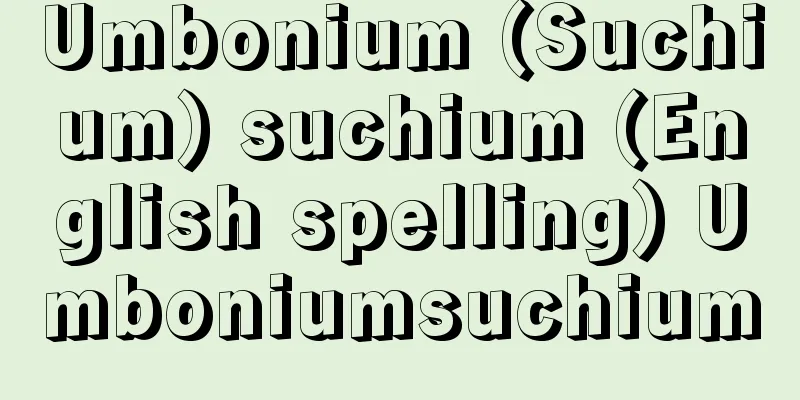Ajikinosho - Ajikinosho

|
This manor was established in the Ajiki district of Kasugabe County, Owari Province, as listed in the Wamyō Ruijūshō. The area of the manor was mainly upstream from the confluence of the Shonai River and the Yada River, and covers the area of present-day Kita-ku, Nagoya City, southwestern Kasugai City, Aichi Prefecture, and southeastern Nishikasugai County. In 914, King Munemasa donated it to Daigo-ji Temple in Kyoto and established it as a manor. It was later confiscated, but in 1143, it was restored to the Daigo-ji Temple territory by the regent Fujiwara Tadazane, and used for repairs and donations for the Kanjō-in Temple. It was later confiscated again, but in 1188, it was restored to the temple territory by Emperor Goshirakawa, and has been handed down as the territory of the Sanbo-in Temple of Daigo-ji Temple ever since. The main part of Shishichi was an area where the jori system was implemented, consisting of 680 cho (160 cho of rice fields and 120 cho of farmland), with 70 zaike (lay people). In response to the obstruction of the land stewardship that was revised after the Jokyu War, the Jike family appointed the Menjo Kesatsurumaru (Nomi and Dokan) of Mitsuhiro and Goromaru headman, who were the lords of the development inheritance, as a custodian in 1281, and had them pay an annual tax of 200 kanmon. Kesatsurumaru's position was confirmed even under the Kenmu government, but during that time there were disputes with the Jitodai over the positions of Goromaru and Mitsuhiro, and the seizure of land by former Kumon Kunimasa and Takada Tamotsu (present-day Kitanagoya City, Aichi Prefecture) and other land stewards. The area was divided into east and west around the beginning of the 14th century. In 1340, there was a dispute with Joshin-in of Daigoji Temple over the name Fukutoku, and in 1427 there was a border dispute with Kashiwai Manor (present-day Kasugai City), owned by Toji-in (present-day Kita-ku, Kyoto City), over Kasukabehara. Source : Heibonsha Encyclopedia About MyPedia Information |
|
尾張国春部(かすがべ)郡の荘園で,《和名類聚抄(わみょうるいじゅうしょう)》に載る同郡安食郷内に成立した。荘域は庄内(しょうない)川・矢田(やだ)川の合流点より上流域を主要部とし,現在の名古屋市北区,愛知県春日井(かすがい)市南西部,西春日井郡南東部一帯にあたる。914年統正(むねまさ)王が京都醍醐(だいご)寺に施入して立荘された。その後収公されたが,1143年前関白藤原忠実により醍醐寺領に復され,修理料ならびに灌頂(かんじょう)院の布施料などにあてられた。その後再び収公されたが,1188年後白河法皇によって寺領に復され,以後醍醐寺三宝(さんぼう)院領として相伝された。四至内の主要部分は条里制の施行地域で,680余町(うち田地160余町・畠地120余町)からなり,在家(ざいけ)70宇。承久の乱後改補された地頭(じとう)の押妨に対し,寺家は1281年開発相伝領主である光弘・五郎丸名主の毛受(めんじょう)袈裟鶴丸(能実・道観)を預所(あずかりどころ)とし,年貢200貫文を請け負わせた。袈裟鶴丸は預所職を建武政権下においても安堵されたが,その間五郎丸・光弘両名主職をめぐる地頭代との相論,前公文国政や高田(たかだ)保(現愛知県北名古屋市)地頭らの押領等があった。14世紀初めころ東西に分かれた。1340年福徳(ふくとく)名について醍醐寺成身(じょうしん)院と相論,1427年には春日部原をめぐって等持(とうじ)院(現京都市北区)領柏井(かしわい)荘(現春日井市)と境相論があった。
出典 株式会社平凡社百科事典マイペディアについて 情報 |
>>: Ashikita [town] - Ashikita
Recommend
Baker, Alan
Born: August 19, 1939, London [Died] February 4, 2...
Shingu [city] - Shingu
A city in the southeastern part of Wakayama Prefec...
Upavasata - Upavasata
...In Buddhist terms, it is a ceremony where prac...
Nobumitsu Aoki
1869-1949 A politician from the Meiji to early Sh...
Yanosuke Iwasaki
Year of death: March 25, 1908 (Meiji 41) Year of b...
《Statue of the Barbarians (■1)》
…He is one of the painters who symbolizes the ris...
Asir Mountains - Asirsanchi
…In the southwestern part of Saudi Arabia, the As...
Housing development - Takuchikaihatsu
The act of developing housing land with considerat...
Johan Huizinga
Dutch historian. Born in Groningen. Studied liter...
Orkhon inscriptions
Inscriptions discovered in 1889 in the Orkhon Rive...
Izumo Hiroshima - Izumo Hiroshima
Year of birth: Unknown A local official in the fir...
Giuseppe Peano
Italian mathematician and logician. Born near Cun...
Emmara - Imaara
...The ancient imperial court rituals of farming ...
Engishiki
This is one of the Sandai Kakushiki (Three Imperia...
Freiburg (Switzerland) (English spelling) Freiburg
The city has a population of 33,000 (1996). It is...









